|
|
|
|
|
|
|
|
|
 Posted: Sun Nov 06, 2005 3:51 pm Posted: Sun Nov 06, 2005 3:51 pm
Something of a disclaimer:
Everything here is from MY teachers Mr. Murphy and Mr. Koyama.Who teach out of the Ima Book 1 published in 2002 by Sue Burnham.YOU MUST HAVE THE SETTING OF BEING ABLE TO READ/ TYPE JAPANESE ON YOUR COMPUTER, IF NOT PM ME! and If it appears as a weird code.... Go to your brower menu, click view>encoding>unicode or a japanese coding only if Japanese doesn't work.
If too many people have trouble I switch back to screenshots. 3nodding
Only one person has had trouble.GETTING AROUND, EXPLANATION, UPDATES
1)Location, explanation, updates, and color coding eek
2) Hiragana eek
3) Honorifics and counting eek
4) Vocabulary I and II eek
5) What's your name? What's your age? Isn't the weather nice? eek
6) My friend pwns you. eek
7) May I borrow a pencil? and Vocabulary III eek
8 ) Vocabulary IV eek
9) TEST
________________________________________________________
10) Vocabulary V and classroom vocabulary eek
11)Geography eek
12) About Kanji(I STILL NEED TO COPY T3H NOTES FROM SHANDI sad ) and Kanji I
13) Where do you live? What's your phone number? eek
14) Hello, Hi, Hey, byebye eek
15) mo, no and translations eek
16) Kanji II and a little classroom culture eek
End of 2nd/6 6 weeks PM me for test
_______________________________________________________
17) (Its a shitload)Common vocabulary, phrases, and hand signals eek
FROM HERE DOWN IS IN (Click here--> wink another post (<--Click here)
18 )Kanji III (to prepare youfor family vocabulary) eek
19) Family vocabulary and where j00 at f00? eek
20) Vocab. VI (including counting people!) eek
21)Cheap conversation.... "Who is in your family?" "How many people are in your family?" "I'm leaving!" (ect.) and "I like cake!" eek
22) Band vocabulary
____________________________________________________________
23) New Kanji and a random number review (all pg 30)
24) Telling time: In five minute intervals (not in notes)
25) Hiragana vocabulary and katakana vocab (all 31 pencil of 33)
26)Various questions using #25's kotoba and ni, o and e as particles (all 32 half of 37 and all of 38 )
27)New kanji (page 34) eek heart
2 cool Day Kanji, Classroom Greeting, Vocabulary, Example sentences eek heart
29)conjugating verbs to masu (35-36, bottom 39)
30) random and fun sentences (you must eat/rock paper sizzors)(top 39)
___________________________________________________________
31)LAWLZ WHAT'S THAT KANJI!? (mid 39)
32) student stuff (41)
32) new vocab (40 and 42)
33)new kanji/vocab (top 43)
33)How when and where do you go (42-43)
34) telling time in 10 minute intervals (not in notes)
^^^the random number are pages in my notes because I don't write a lot of stuff down during class. I just jot little notes down to myself so I'll remember to tell you guys stuff.)THE WHYI'm sick of everythread here being teach me Japanese. That's it. That's why I made this thread. I'm in Japanese one right now so you're learning everything I am. Okay.Quote: Updates
I'm in North Carolina, D.C.,and then Ocean City, Maryland the next couple weeks. Then I'm spending a few days of tennis/ boyfriend/ bestfriend. Sorry about the ridiculous lack of updates. Thank you for your understanding.
5/25/06
Alright
So I haven't updated in nearly two months.
Finals are next week and, as you can imagine, I am stressed.
So I'll be COMPLETING THE THREAD not this weekend. Not the next. Not the next. But the one after that.
So yeah.
Just so you know.
Gaia,
I have not abandoned, ye.
3/11/06
HEY, IT'S SPRING BREAK AND I HAVE A ******** PROJECT TO DO. I've never used a camera in my life, so this will be frustrating. I'm also considering deleting these posts and quiting the guild because the leader's absence pisses me off. But other than that, a lot of updates. And sorry a lot of things have been turning into question marks, I keep forgetting I can't update with safari.?oH, i'm looking for someone to help me edit the threads. you know, suggest different topic orders, point out spelling/ grammar mistakes. Suggest things such as decortations I should put in. basically do everything I'm not doing... and that's a lot. If anyone is intrested, AIM or PM me.
[2/12/06 Almost Valentines day which means one day until I'm 15. Yay. I've been EXTREMELY stressed out with school- esp. Japanese. I'm struggling to maintain an A and if I don't have an A I don't feel like I'm qualified to teach it on this forum to you.... coming soon on the forth or third six weeks: Breakfast item vocabulary, Morning routine questions, dates, and CONJUGATING VERBS TO MASU FORM. So bear with me here. And.. If you find the thread confusing.... please... PM me and tell me what is confusing and I'll be more than happy to change it. DON'T ask for private lessons because I will only say the things that are on this thread.
[/rant]
1/21/06
The thread is completely up to date.
1/15 I'm finishing all that I can (EVERYTHING UP TO POST 17) and I'm continuing the rest of the stuff in another thread. After I'm done with the Japanese1 tutorial I'm thinking aboout joining other guilds as well and replicating this tutorial. Just a thought.
Violet= contests *found under updates*(before I have one I'd ask the the guild to fund it and for the guild to fund it more people have to donate!)
Cyan= I'm not sure. To correct me, PM me. In that case if any thing is wrong (Spelling, grammatic, ect.)please PM me, notifying me about it.
Indigo= topic change
arrow = Change in thought/ new paragraph, but on the same topic and sub-topic.
---= change in subtopic
Dark red= Regular writing
heart = new
eek = post's layout and information is complete.
My Plan (Goal: Will be finished by summer 2006)
1) Complete it
2) Make the two threads in this guild one and have the older two deleted/ locked
3) Spread the thread to every major guild(major guild= with 200+ members) in gaia.
|
 |
 |
|
|
|
|
|
|
|
|
|
|
|
|
 Posted: Sun Nov 06, 2005 3:54 pm Posted: Sun Nov 06, 2005 3:54 pm
HIRAGANA
Going around and memorizing this hiragana chart doesn't help. Believe me. I've tried it with katakana. So do not memorize all the hiragana immediately when you see this post. Use this post as reference. Go on to the next post where the first word you will learn is "Sama". Go up to this post and look at the characters "sa" and "ma". Learn all your characters liek this and by the end of the first six weeks you should have all your hiragana learnteded.
As a begginner, you will learn most things in hirgana before you learn kanji and I will only give you a little kanji at a time to learn
arrow In Japanese there is furigana, romaji, katakana, hiragana and kanji.
arrow You could be able to fluently speak Japanese and not be able to read or write it and so there is hiragana and furigana.
arrow Hiragana is a rounded, curly script which was created by modifying a small number of Chinese characters Hiragana in general appears with the combination of Kanji, which represent the core of many words, in normal writing. Just like katakana, hiragana are phonograms, representing sounds. All the words I teach in the first six weeks are in hiragana but should be written in kanji. (Sorry guys but you learn the kanji later...) HIragana is often used inbetween kanji as particles and to identify the parts of speech. They are ESSENTIAL for learning kanji.
arrow Furigana is hiragana above kanji for people who don't know the kanji.
arrow Romaji is the way we write Japanese out. For example; the word hiragana.
arrow Kanji represent ideas, thats what makes them ideograms. There are thousands of them. 2,000 are in common daily use. People dedicate their whole lives to learning Kanji and don't even get half way there.
arrow Katakana is what you use to write down English words, translating them by sound.
Examples confused
Kanji: 日本語
Hiragana:にほんご
Katakana:ニホンゴ
arrow Keep in mind there is only one way to write everything. A "stroke order". So in Japanese to be fluent you must: Know A lot of kanji, all the hiragana (katakana is optional), speak it (duh), and know stroke order.
arrow
arrow HIRAGANA CHART: (It forgot wa.... which is odd.)

------
arrow STROKE ORDER
arrow The basic stroke order is (1) write across from the left to the right, then (2) write down from the top to the bottom, although there are a few exceptions when the letter does not consist of straight horizontal or vertical strokes.
arrow All letters should be written approximately the same size.
arrow The hooks you see in the writing give you a clue as to where the next stroke will be. These hooks ate... and the bottom of the first stroke of ka, the bottom of the first stroke of ha, ect. You NEED them. Get in the habit of exaggerating them because the hook help with kanji. Calligraphy writing looks different. strokes tend to hook together because of the brush dripping when you lift it up. Computer typing it calligraphy and so are signs in Japan, but NOT writing. SO don't try to write calligraphy.
arrow When you write it may be a good idea to write in graph paper having a certain amount of boxes per character (I can do one*except with kanji I do four*, but I got skill xD). No matter how complex each character is, it only takes up a box of space.
arrow Don't write with your wrist moving too much like most people do when writing English. Try to write from your elbow. It will look worlds better.
arrow On SO just pretend to be writting a squiggley with TE underneath it.
arrow Take note that the things on the G,Z,D, abd B rows hand tenten (that two little dot things that looks like ") and the P row has maru (the little circle thinggy) You might need to know later that that's what they're called *winkwinknudgenudge*
    
   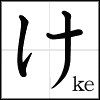 
   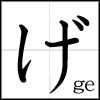 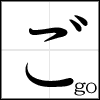
    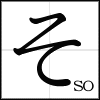
    
  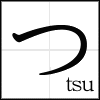  
    
    
 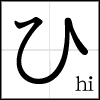   
    
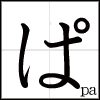 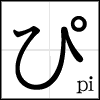  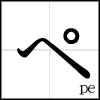 
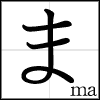    
 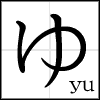 
    


-----
arrow Every hiragana character gets one beat when talking. Its like talking to a metronome (not at all like English). If you wish to be understood correctly you must talk in a beat, it doesn't matter how fast or slow this beat is. FASTER ISN'T ALWAYS BETTER!
arrow The A is pronounced like the A in pa or park
The I is pronounced like the E in key or weeeee
The U is pronounced like eeewww or the U in emu
The E is pronounced like the e in pet
The O is pronounced like the O in Ho or grow
The R?s (ra, ri, ru, re, and ro) and a bit harder to pronounce (that is, if you don't speak Spanish *more about that next paragraph*) start your tongue in the position of you're about to say dog, then switch to an r. Don't move your mouth too much.
arrow SPANISH MAY NOT BE YOUR BEST FRIEND! Spanish pronunciations are extremely similar to Japanese, but the sounds are just a itty bit different. I don't speak Spanish so I don't know too much, but there's a girl in my class who speaks Spanish and hasn't learned the Japanese pronunciations so you can tell just a slight difference. Don't get me wrong, Spanish is cool.
arrow Extra: you may notice that there are no spaces in Japanese writing; however you don't talk that way. There are natural pauses and pauses after commas and periods. It mainly comes from experience, though.
-----
arrow To remember the KGSZTDNHBPMYRWN on the side remember:
Kids Grow So Zealous That Deranged Neighbors Hurry By Panicking Many Yelling Ridiculous Words Non-stop.
arrow MNEMONICS
Mnemonics help you remember things. Like hi (the character) hi looks like a smiley face smile laughing hihihihi.... and mi looks like 21 mi can't wait 'till mi 21.
Mnemonics are your friend!
arrow To learn all this I suggest flash cards using a different color for the A I U O and E rows. Allow yourself a couple weeks to learn all of it and drill with the flash cards frequently. If you think you've learned it test yourself by writing the whole thing out on a blank sheet of paper. For every character you write wrong/ forget is a whole other chart with a maximum of 20. biggrin
arrow Another way to learn all of the hiragana and learn them with words. for example, you would skip the whole writing part of the hiragana in this section (but still read the speaking part!) and learn the hiragana with words. For example, in the next section the first word/honorific you will learn is sama. Not knowing any characters, you would come back to this section and learn them. It?s like learning as you go. It REALLY WORKS. BUT when you learn the K, S, T, and H rows, you will also learn the G, Z, D, B, and P sections because they are the same thing, just with the tenten or the maru.
Don't even attempt to advance until you know all of this.
arrow Excellent site for learning hiragana and katakana mnemonics http://www.kanachart.com/
EXCEPTIONSYa, yu, yo and tsu often attach to other characters. (Other charcters can attach, but it's rare.) This attachment is shown by the attached character being 1/4 the size of all the other writing.
Example: ちょっとまってください((Wait a minute))
The attached character can give the sound of a double consonant and since it hooks to another character, it shares the beat. The tsu will add a t sound at the end of the previous character while the ya yu and yo are slurred to the other charcter. The smaller character attached to the previous not only hooks to it but emphasizes the sound of the next character and usually (if not always) deletes the previous character's vowel.
|
 |
 |
|
|
|
|
|
|
|
|
|
|
|
|
|
|
|
 Posted: Sun Nov 06, 2005 3:58 pm Posted: Sun Nov 06, 2005 3:58 pm
HONORIFICS
So you've watched anime and read manga and you probably know a little about honorifics, but I just want to get everything straitened out for a few of you who may not know some of this.
Short rules
arrow It's rude to adress someone with the wrong honorific
For example
Bob: Teacher, my dog ate my homework!
Teacher: I'm sorry Bob-sama I understand.
Referring to the student as a God would be sarcastic and sarcasm in Japan isn't as widely accepted as in America
arrow Rude/ confusing to refer to yourself as an honorific
Example:
I'm Mr. Bob.
arrow It's rude to address a Japanese person without an honorific.
Honorifics:
さま Meaning: "Oh, exhaulted one" Used for: Gods, rulers or used to show upmost respect
せんせい Meaning: Teacher Used for: teachers
さん Meaning: "Mr./Mrs." Used for: Anyone but rulers and teachers
くん Meaning: Casual and used for boys by boys
ちゃん Meaning:intimate/ casual often used by/ for young girls/ kids.
---
Family names
We usually refer to ourselves by our first name, but in Japan, unless you are close to that person, you refer to them by their last name.
arrow "last" name= surname/ family name
"first" name= name, given name
In Japanese you use your family name often times as a first name.
arrow Example: English name: Chuck Jones
Japanese name:Jones Chuck-san
NUMBERS
I teach the kanji later on. I always found kanji overwhelming so I teach the hiragana first.
Mnemonic
arrow Here's a mnemonic for numbers 1-5!(itchy knee sun she go)
Close your eyes and imagine a sweltering hot day. There's a lady running the track with a brace on her knee cap. She just keeps running the track and the dirt she has kicked up while running has gone under her brace. Thus, while she's running, she itches her ichy knee under the hot sun, but she keeps going and going.
Explanation
arrow 1as いっ -->いち is only read いっ when combined with other words (more on that later)
arrow 4 (よん)The number four is a super stition, very much like 13 being unlucky in the US. In Japan the number four (し) means death. Things aren't sold in packages of four because it's like saying, "Here. Die." That's why yon is another way to say four.
arrow 7 (なな/ しち)- shichi is also called nana to seperate its similarity from 8 (hachi).
arrow 9(きゅう/ く)- きゅう is often what is written, but when spoken きゅう is often shortened to く.
Counting numbers 1-999
1 いち or いっ
2 に
3 さん
4 よん or し
5 ご
6 ろく
7 なな or しち
8 はち
9 きゅう or く
10 じゅう
100 ひゃく
arrow If you're familiar with roman numerals, this shoud be a breeze.
The number 11 would be じゅういち(10+1)
The numer 21 would be ni jyuu ichi (2*10+1) にじゅういち
The number 321 would be san hyaku ni jyuu ichi (3*100+2*10+2) さんひゃくにじゅういち
and so on.... and so forth....
|
 |
 |
|
|
|
|
|
|
|
|
|
|
|
|
 Posted: Sun Nov 06, 2005 3:59 pm Posted: Sun Nov 06, 2005 3:59 pm
[ Message temporarily off-line ]
|
 |
 |
|
|
|
|
|
|
|
|
|
|
|
|
|
|
|
 Posted: Sun Nov 06, 2005 4:02 pm Posted: Sun Nov 06, 2005 4:02 pm
What's your name? What's your age? Isn't the weather nice?
What's your name?
IF IT CAN BE UNDERSTOOD, IT CAN BE OMITTED!
(SO THE SECOND TWO ANSWERS AREN'T TOO COMMON BECAUSE YOU ARE, OF COURSE, SPEAKING ABOUT A NAME AND IT IS CLEARLY YOURS.)
arrow (は is a partical and is read as wa)
Question: なまえは?(Not impolite but NEVER USED FOR SUPERIORS DAMMIT)Meaning: As for you name... (most commonly used)
or
or
おなまえは (semi-polite *made polite by the お*)Meaning: As for your name, it is...
おなまえはなんですか (not commonly used. If you do use it... use it for superiors.)Meaning: What is your name?
Answering:
[name here]です。 Meaning: It is [name].
or
なまえは [name]です。 Meaning: The name is [name].
or
わたし(or ぼく)のなまえは [name here]です。 My name is [name].
What's your age?
Question: なんさいですか How old are you?
arrow When answering just delete the question words!
Answer: [age]さいです。
If answering this, if you're 1,11,21,31,41 ect. (your age ends with one, the 「いっ」 is cut short.
Example: わたしはにじゅういっさいです。
Isn't it good weather?
Questions:
いいてんきですね?? Isn't it good weather?
さむいですね? Isn't it cold?
ひどいあめですね? Isn't it bad rain?
あついですね? Isn't it hot?
Answering: そうですね。 Meaning: "Yes, isn't it?" in context but can also mean "Let's see..."
arrow If the weather is cold, bad rain, hot, or good isn't up to you. It's a standard. So even if you like rain, it isn't good weather. Sorry!
Rain=bad Sweat=hot. Sunny and breeze= nice. It isn't up to you!
arrow You need the ね? at the end of the sentence at the end so you won't sound like a dictator. The Japanese don't like to force their opinions. So, if you don't put a ね? at the end you sound like... IT IS HOT! IT IS COLD! ect.
arrow These weather conversations can be used with anyone, whether they are close to you or a passing stranger. It's similar to saying "How are you?"
|
 |
 |
|
|
|
|
|
|
|
|
|
|
|
|
 Posted: Sun Nov 06, 2005 4:02 pm Posted: Sun Nov 06, 2005 4:02 pm
My friend pwns you.
Using previous vocabulary I will make sentences!
arrow これはわたしのいぬです。
Literal translation: As for this thing my dog it is.
Translation: This is my dog.
arrow このひとはぼくのともだちです。
Literal translation: As for this person my friend it is.
Translation: This is my friend.
arrow これはさわこさんのねこです。
Literal translation: As for this thing it's Sawako's dog.
Translation:This is Sawako's dog.
arrow これはわたしのともだしのうちです。
Literal translation: As for this thing my friend's house it is.
Translation: This is my friend's house.
arrow The sentences are very self explanatory. All it is is putting the vocabulary together biggrin
|
 |
 |
|
|
|
|
|
|
|
|
|
|
|
|
|
|
|
 Posted: Sun Nov 06, 2005 4:05 pm Posted: Sun Nov 06, 2005 4:05 pm
VOCABULARY III
えんぴつ Pencil
しゃあぷぺん Mechanical pencil
ぼおるぺん or ペン Pen
けしゴム (けしごむ) Eraser
マーカー (まあかあ)Marker
かみ Paper
はさみ Sizzors
じょうぎ Ruler
ふでばこ Pencil case
のり Glue
ほん Book
arrow Trouble learning this vocabulary? You're not alone. I felt stupid because I couldn't remember anything. Draw pictures and then label them (by hand) in Japanese and in English (or soemthing along these lines). You could make flashcards! Also, you could make mnemonics for the words: Pen sounds like borrow pen, paper sounds like call me, marker sounds like marker.
かして(ください) politely means "GIMME!"
どうぞ take it
Thank yous:
ども (most casual) Use with friends
どもありがとう (Semi- casual) Use with people you kind of but dont reall know?
ありがとうございます (very polite) use with teachers ect.
ASKING
Casually (torwards friend's): [Item], かして。
Politely (To adults or strangers): {item} をかしてください。
Conversation examples:
#1
Bill: えんぴつかして。
Bob: どうぞ。
Bill: ども。
#2
Bill: えんぴつをかしてください。
sensei: どうぞ。
Bill: ありがとうございます。
***Culture:
In Japan when lending something to someone you must hand it up with two hands as if raising it up above you. You CAN NOT just toss it aside to them with one hand as we do in America. That is VERY disrespectful. Also, when giving it *up* to them it is good to have a little bow. This is because in the olden days a King or Emporer would just toss things aside when asked and you wouldn't want to refer to yourself as an emporer becuase that is extremely egotistical.
Duh gawsh. xDD
|
 |
 |
|
|
|
|
|
|
|
|
|
|
|
|
 Posted: Sun Nov 06, 2005 4:06 pm Posted: Sun Nov 06, 2005 4:06 pm
Vocabulary IV
arrow I believe earlier (in my second post) I stressed how important it was to give each character a beat (as if to a metrinome). Here are some examples why.
とおいFar away
いいえ No
ええYeah
かわいい Cute
おおきいBig
あたらしいNew
---
School Vocabulary
こうこうせいHigh school student
ちゅがくせいMIddle school student
しょうがくせい Elementary school student
ようちえんせい Kindergarden student
がくせいStudent
---
Misc.
じてんしゃ Bicycle
みどりの Green
なにを... What are you doing...?
|
 |
 |
|
|
|
|
|
|
|
|
|
|
|
|
|
|
|
 Posted: Sun Nov 06, 2005 4:07 pm Posted: Sun Nov 06, 2005 4:07 pm
|
|
|
|
|
|
|
|
|
|
 Posted: Sun Nov 06, 2005 4:09 pm Posted: Sun Nov 06, 2005 4:09 pm
Vocabulary V
もって (ください) Wait a minute
がっこう School
たてがき Vertical writing
よこがき Horizontal writing
ゆっくり Slowly
ちょと a bit
げtぺ burp
しゃってくり hiccup
きって stamp
さっし magizine
ページ (ぺえじ) page
おめでとう congratulations
から from
なん what
しつもん question
~ is read naninani and it represents a blank space.
がんばって (ください) Don't give up/keep going
すわって (ください) sit down
たって (ください) stand up
ちょっとまって (ください) Please wait a minute
きょうしつのことば Classroom Vocabulary
ちょっとまって (ください) Please wait a minute
こくばんをみて Please look at the board
しずかにして Please be quiet
テエプをきいて (てえぷをきいて) Please listen to the tape
ほんをひらいて Please open your book
~ページをひらいて (ください) Please open to page
こくばんをみて Please look at the board
しずかにして Please be quiet
テエプをきいて (てえぷをきいて) Please listen to the tape
くりかして (ください) Please repeat what i'm saying.
こたえて (ください) Please answer
かいて (ください) Please write
すみません。しつもんがあります。 Excuse me. I have a question. (masu makes it very polite. So if you were speaking to someone your age you could leave masu and the sumimasen out.)
~はにほんごでなんですか What is ~ in Japanese
~はえいごでなんですか What is ~ in English.
といれいっていいですか。 May I go to the bathroom
これはなんですか。 What is this.
|
 |
 |
|
|
|
|
|
|
|
|
|
|
|
|
|
|
|
 Posted: Sun Nov 06, 2005 4:10 pm Posted: Sun Nov 06, 2005 4:10 pm
Geography Islands1 ほっかいどう 北海道 Islands1 ほっかいどう 北海道
2 ほんしゅう 本州
3 しこく 四国
4 きゅうしゅう 九州Major Cities5 さっぽろ 札幌
6 とうきょう 東京
7 よこはま 横浜
8 きょうと 京都
9 なら 奈良
12 ながさき 長崎
13 ふくおか 福岡
14 ひろしま 広島
16 おおさか 大阪
Cities important to me11 くまもと 熊本
15 まつえ 松江
17 かなざわ 金沢Major Volcanoes10 あそざん 阿蘇山
18 ふじさん 富士山A little about a few of those cities arrow Hiroshima and Nagasaki were bombed during WWII
arrow Maybe you're use to saying the americanized versions of tokyo and kyoto. That stops. Now. x_x
arrow Kanazawa is important to me because in my text book the family that the book is about lives in Kanazwa... and it sounds cool.
arrow Matsue is where my Japanese student teacher is from
arrow Kumamoto is important to me because it is San Antonio's (in Texas....) "sister city" while Kumamoto has a castle, San Antonio has the alamo is the most obvious part of t3h sisterness. If I went to Japan, I'd want to go to Kumamoto!
When learning this in class I was expected to.
a) Label all of these on a blank map
b) Know howo to say them correctly
c) RECOGNIZE the kanji DO NOT write it... don't want anyone picking up bad stroke habbits...
For recognizing the kanji I suggest mnemonics and flashcards.... I'm not going to give you my mnemonics (I had one for every city) because they are stupid.
Example: さっぽろ's kanji looks like a guy holding a sword and that's why it's the only city on that island.
...so yeah.
Luck heart
|
 |
 |
|
|
|
|
|
|
|
|
|
|
|
|
 Posted: Sun Nov 06, 2005 4:31 pm Posted: Sun Nov 06, 2005 4:31 pm
About Kanji
Identifying radicals
I STILL NEED HALF OF THE RADICAL NOTES FROM SOMEONE IN MY CLASS. SORRY!
arrow Radicals are simple characters (or simplified forms of characters) that appear as a part of a new character
arrow They help identify meaning
arrow They help identify pronunciation
Kanji basics
arrow Kanji represent ideas, not sounds.
arrow All kanji have a stroke order and stroke number
arrow All kanji have 「おんよみ」 "On" reading based on the sound the character made when pronounced in Chinese
おんよみ
arrow This reading is usually what is used when kanji are combined
arrow Many simple kanji have more than one reading
arrow This reading is the Japanese imitation of Chinese
くんよみ
arrow Means trained reading
arrow Comes from the Japanese pronounciation of kanji
arrow This reading will beused when kanji represents a word by its self
arrow There are 2,000 kanji in average daily use
Kanji I
exclaim The kanji I give you will more often than not be in the following format....
Kanji
Link to page with stroke order
on reading
kun reading
imi (meaning meaning)
exclaim Peice of advice when writing kanji... if you aren't sure of the stroke order... remember: when writing a box the first two strokes are always the same and you write what is inside the box before closing it. Remember hooks show you when the next stroke will be. And you try to go from upperleft hand corner to lower right hand corner. It's more important, though, to end at the bottom than at the right.
arrow Whe I put a star it means that the part before the star is the kanji and the part after the star is written in hiragana aften the kanji often to identify the part of speech
日
http://www.a-chi.jp/_1_nen_Flash/1-66.swf
にち*じつ
ひ*か
Sun, day,
本
http://www.a-chi.jp/_1_nen_Flash/1-74.swf
ほん
もと
book, origin
語
http://www.a-chi.jp/_2_nen_Flash/2-044.swf
ご
かた*る
Language, to tell a story.
今
http://www.a-chi.jp/_2_nen_Flash/2-058.swf
こん*きん
いま
now
kanji numbers
1 一
http://www.a-chi.jp/_1_nen_Flash/1-01.swf
2 二
http://www.a-chi.jp/_1_nen_Flash/1-65.swf
3 三
http://www.a-chi.jp/_1_nen_Flash/1-25.swf
4 四
http://www.a-chi.jp/_1_nen_Flash/1-28.swf
5 五
http://www.a-chi.jp/_1_nen_Flash/1-21.swf
6 六
http://www.a-chi.jp/_1_nen_Flash/1-80.swf
7 七
http://www.a-chi.jp/_1_nen_Flash/1-32.swf
8 八
http://www.a-chi.jp/_1_nen_Flash/1-70.swf
9 九
http://www.a-chi.jp/_1_nen_Flash/1-13.swf
10 十
http://www.a-chi.jp/_1_nen_Flash/1-35.swf
100 百
http://www.a-chi.jp/_1_nen_Flash/1-69.swf
|
 |
 |
|
|
|
|
|
|
|
|
|
|
|
|
|
|
|
 Posted: Sun Nov 06, 2005 4:32 pm Posted: Sun Nov 06, 2005 4:32 pm
Where do you live? What's your phone number?
Vocabulary
どこ Question word meaning where
に particle meaning in (a place), to (a place), at (at time)
すんでい "I am living" Compound verb of:すむ(to live) and いる (to be)
でんわ telephone
ばんごう number in context of something assigned
Where do you live?
Q: どこにすんでいますか since ます makes it polite... the question could be どこにすんでいか
A: ____にすんでいます。or
Name (if talking about someone else) or (ぼく or わたし) は_____にすんでいます。
What's your number?
Q: [name here]のでんわばんごうは or でんわばんごうは
A: [name] は ###の####。 or ###の####。
The の represents the - inbetween telephone numbers.
|
 |
 |
|
|
|
|
|
|
|
|
|
|
|
|
 Posted: Sun Nov 06, 2005 4:34 pm Posted: Sun Nov 06, 2005 4:34 pm
Hello, Hi, Hey, byebye
あいさつ Greetings. Unlike in English, the word greetings can't be used as a greeting. Be careful of dangerous confusions like that.
おはよう(ございます)(Good morning for only the first timeyou see them. Add the gozaimasu forpeople of higher stature than you.)
今日は こんいちは Hello (In the afternoon)
今ばんは (In the evening)
さようなら Goodbye (for people of higher stature than you. If you'relike a teenager and use it to people of your own age, it'sprobably closer to "see you in hell" than to "bye".)
じゃまたね じゃまた じゃね A casual bye
バイバイ ばいばい A bye used only by girls
おやすみなさい Compound verb of やすむ and やすみ. Means goodnight.
おやすみな To rest
やすむ Also, to rest.
やすみ Vaction/holiday
|
 |
 |
|
|
|
|
|
|
|
|
|
|
|
|
|
|
|
 Posted: Sun Nov 06, 2005 4:35 pm Posted: Sun Nov 06, 2005 4:35 pm
も, の and Translations
も
も replaces は and means also or me too
Example:
ゆきこさんは十二さいです。
たかしくんも十二さいです。
Not that we stated Yukiko was twelve before saying the Takashi is ALSO 12.
の
の can act as an apositive, but unlike the commas, you don't need a の on each side.
まさるくんは十五さいです。Masaru is 15.
まさうるくんはこうこうせいです。Masaru is in high school.
まさるくんは金沢にすんでいます。Masaru likevs in Kanazawa.
This can be put into one sentence:
まさるくんは十五さいのこうこせいの金沢にすんでいます。
mrgreen Simeple stuff.
Translations
I'll be brief. I don't like translating. I'm not good at it sad But when you translate you use katakana (which I won't teach you until Japanese II, but I'llbe happy todirect you to sites). Also, when translating you try to make it sound like it does in English.
Examples: クリス=くりす=Chris So, as you see, you will katakana
for your English name smile I was absent that day in class.... so that's really all I can give you.
|
 |
 |
|
|
|
|
|
|
|
|
 |
|
|
|
|
|
|








































































